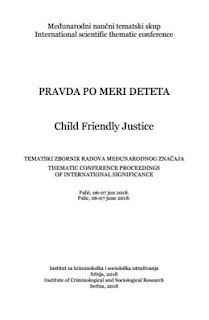CHARACTERISTICS OF ANTISOCIAL BEHAVIORS AMONG RISKY GROUPS: PSYCHOPATHY-LIKE CHILDREN, DELINQUENTS, AND OFFENDERS
Janko Međedović (a), PhD
Meri Stojković (b), MA
a) Institute of criminological and sociological research, Belgrade
b) Faculty of philosophy, University of Priština, Kosovska Mitrovica
Email: merinesic@live.com
Schizotypal traits as predictors of criminal behavior in adolescents and adult convicts Schizotypy is a disposition towards psychotic experiences; it represents subclinical
levels of psychosis proneness and thus, exits not only in clinical but in a general population as well. Previous research showed that schizotypy can predict criminal behavior but two questions remain unanswered: 1) What specific schizotypal traits are the facilitators of criminal behavior? 2) Does the role of schizotypal traits in
prediction of criminal behavior differ throughout developmental stages? We tried to provide the answers to these questions in two samples of convicted individuals.
We measured schizotypy using the Disintegration construct which covers ten narrow modalities of schizotypal traits. We explored criminal behavior by measuring the onset of criminal activity, number of criminal offenses, convictions, and prison sentences, together with the general criminal recidivism variable.
In study 1 we explored the relations between schizotypy and criminal behavior in the sample of institutionalized male adolescents (N=100; Mage=17.6; SD=1.49). We
found positive associations between Mania, General Executive Impairment,
Flattened Affect, and the indicators of criminality; we also detected negative
correlations between Magical Thinking and criminal behavior. We run a regression model where participants' age and the Disintegration modalities were entered as predictors while the general factor of criminal recidivism was set as the criterion
variable (R²adj=.23; F(11,89)=3.76; p<.001). We found independent contributions of General Executive Impairment (β=.29; p=.01) and Mania (β=.38; p=.001) to the regression function. Study 2 was conducted in the sample of adult male convicts
(N=157; Mage=35.17; SD=10.08). The results showed positive correlations between General Executive Impairment, Paranoia, Somatoform Dysregulation, Flattened
Affect, Perceptual Distortions, Depression, Social Anhedonia, and the measures of criminal behavior. In the regression model which was identical to the one conducted in Study 1 (R²adj=.08; F(11,89)=2.21; p=.017) we found independent
contributions only for General Executive Impairment (β=.32; p=.019) and Magical Thinking (β=-.25; p=.017).
The results of both studies are congruent in the finding that lower levels of executive functioning represent developmentally stable facilitator of criminal behavior. Furthermore, they open a possibility that differentially-diagnostic indicators of psychosis have more prominent role in the criminal behavior of adults:
Paranoia, Somatoform Dysregulation (the impression of a change of internal
organs) and Perceptual Distortions (depersonalization and derealization). Finally, schizotypy is much better predictor of criminal behavior in adolescents than in adults - a finding which may be explained by elevated activity levels and diminished
attention in adolescents. In sum, obtained findings confirm the place of schizotypy in a psychological profile of a criminal offender.
Keywords: schizotypy, criminal behavior, executive functions, adolescents, adult convicts


Коментари
Постави коментар